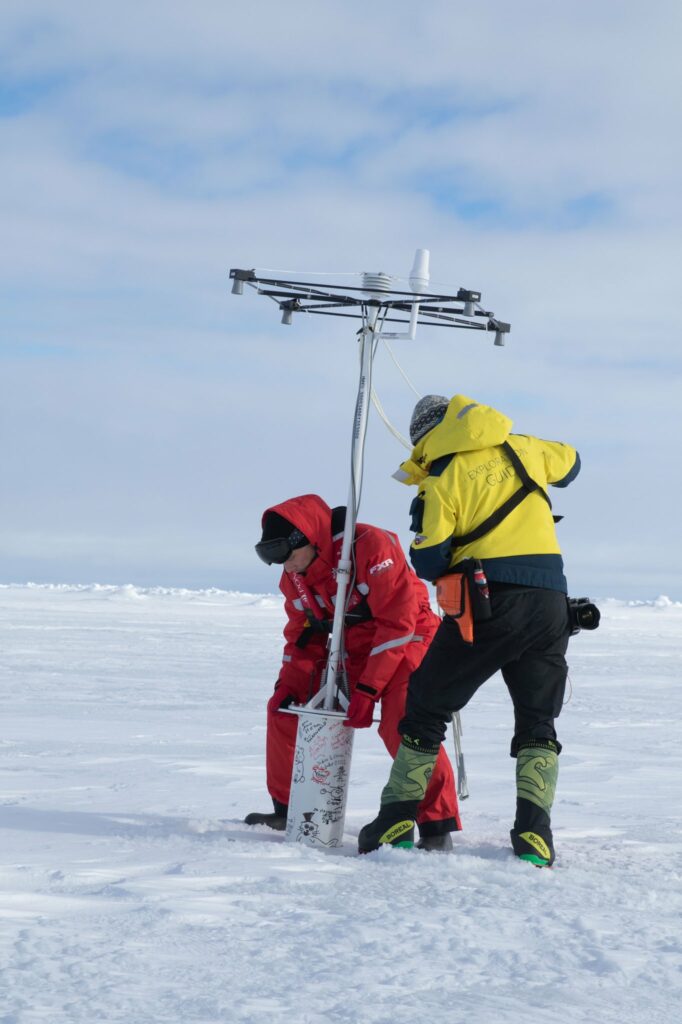After a long hiatus courtesy of the demise of the annual Barneo ice camp and the Covid-19 pandemic we are pleased to be able to report that an ice mass balance buoy has once again been installed on a floe in the vicinity of the North Pole. Here’s the evidence:

The ship in the background is not a traditional research icebreaker. It is Ponant Cruises’ Le Commandant Charcot, one of a number of new ice hardened cruise ships voyaging across the Arctic Ocean and adjacent seas. Le Commandant Charcot reached 90N on July 13th:

However he was beaten to the polar punch by the Russian nuclear powered icebreaker 50 Let Pobedy. This picture is dated July 12th, when snow looks to have been falling at the top of the world:

We are eagerly awaiting data from the newly installed buoy, but it seems we will have to wait a little longer:
However a snow buoy was also installed by the Alfred Wegener Institute at the same time as the SIMB3:

Data from that one is already available for download from the AWI web site. Whilst we await some thickness numbers, sea ice concentration around the Pole is currently remarkably low for the time of year. Here is a recent “false colour” MODIS image of the far north:

Here too is the latest AMSR2 sea ice concentration map of the Arctic Ocean:

There’s a clearer view of the fractured sea ice near the North Pole from on high this morning:

Click the image for a closer look.
[Edit – July 30th]The Norwegian research icebreaker Kronprins Haakon reached the North Pole on July 28th. Here are a few photos commemorating the event:


According to this (auto-translated) Norwegian language article:
The ship reached the North Pole at 15.30. It was several days earlier than expected.
“We know that the Arctic Ocean is changing, but we did not expect the changes to be so extensive”, says expedition leader and director of the Polar Institute, Ole Arve Misund.
The ship set course for the North Pole from Tromsø on 19 July. According to Misund, they had expected to use longer time and more engine power to reach the North Pole.
“We were prepared for much more ice-breaking. But for long periods we have had open leads all the way through”, he says.
As we previously surmised, that “we” is plural:
P.S.

A glimpse of large areas of open water only a few kilometres from the North Pole this morning:

Here too is the current AMSR2 sea ice concentration map of the Arctic Ocean:

A clearish view of lots of open water north of 85 degrees:

Another look at the area of open water near the Pole:

Watch this space!
Le Commandant Charcot is currently taking another trip to the North Pole:
He seems to be leading the way for the Norwegian icebreaker Kronprins Haakon!
Multiple icebreakers plowing up the (relatively) thin ice at the North Pole at the height of summer when the air temps are slightly above freezing. What negative effects can that possibly have? Heisenberg Uncertainty at work…
Particularly given the total area of open water already present in the vicinity of the Pole the effects of a few exceedingly thin icebreaker induced leads will be negligible.
Heisenberg’s uncertainty principle notwithstanding!
Too late. Arctic explorers of the late 1900s made the attempt not by jetski but by dogsled. Inuits lived in igloos year round in the 50s and now walk the Arctic shores in summer without a coat. There is no uncertainty since we continue to take stored carbon in oil and gas and put it into the air. Now the 9 billion tons of carbon frozen into permafrost is mostly melted and is ready to become CO2 by bacterial action. An icebreaker trail is nothing when you see hundreds of square miles of ice with meltwater covering it. Ice reflects 97% of the sunlight that hits it. Meltwater on top significantly reduces the number. BTW, what is in the air plus what is in the permafrost takes us to 3 degrees over normal.
The perma frost melt becomes methane which is about 30 times more of a greenhouse gas which is scary enough .. the methane hydrate deposits are another thing and far more damaging
[Combined 2 comments – Mod]
I too have wondered if we should be breaking the ice like this at both poles. Loving them to death? Granted my knowledge of ice pack is limited.
50 Let Pobedy has taken another trip to the Pole:
It was slightly sunnier on this occasion!